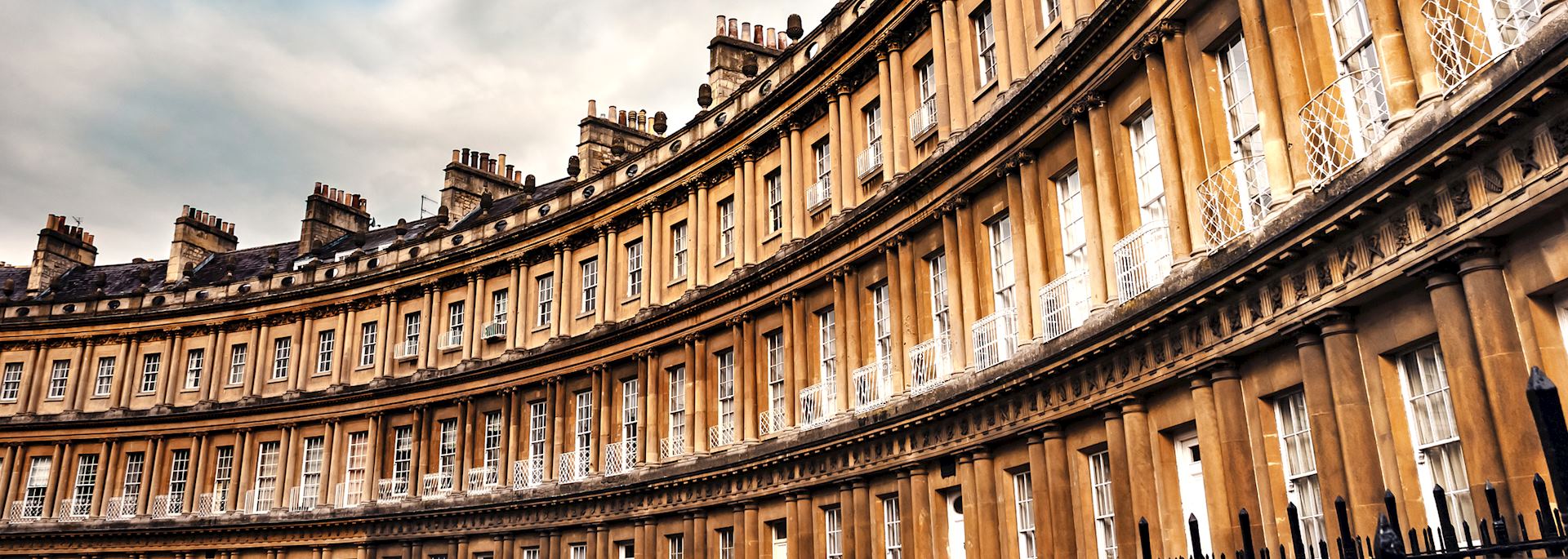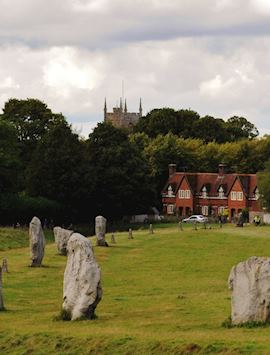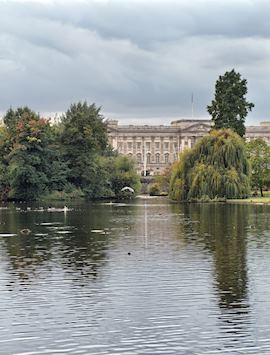By Audley specialist Elizabeth
Speaking as an American, I’ve always found the scope of England’s somehow bottomless past enthralling: the fact it dates back millennia, compared with less than 400 years in the USA. Even if you’re not an avid history enthusiast, it means you’re bound to find something in England’s past that piques your interest. It would be disingenuous to cover the entire sweep of England’s historic sites in one article, so I’m mostly homing in on those with royal history, a personal fascination of mine.
The monarchy’s personal dramas have sometimes directly impacted, even woven the course of politics, hegemony and social change. Just think of the aftershocks of Henry VIII’s divorce from Catherine of Aragon: he seized Hampton Court Palace from Wolsey after the cardinal failed to arrange the king’s marital affairs as he wished, and the Crown’s rupture with the Catholic Church ensued.
London's historic highlights
St Paul's Cathedral

The alabaster-white dome of St Paul’s stands out among the spiky mass of London’s financial district skyscrapers. Its position in the London skyline has become something of a symbol of resistance for the city’s inhabitants: having burned down in the Great Fire, it was then reincarnated with Sir Christopher Wren’s Baroque design in 1710. Then it survived the Blitz of World War II (despite a Luftwaffe bomb lodging in the dome on one occasion).
St Paul’s impressed me even more when I stepped inside. My guide led us through spiral staircases to reach the first of the galleries nested inside its dome (actually a series of three domes), the Whispering Gallery.
You gaze up at Thornhill’s frescoes of the life of St Paul on the dome’s underbelly, peer at the chessboard-like nave floor below, and will probably want to try out the gallery’s celebrated acoustics. Lean your head against the wall, and you can hear a companion’s whisper even if he or she is standing 34 m (112 ft) away from you. Carry on to the next two galleries, the Stone and Golden Galleries, for 360-degree panoramas of London’s cityscape.
If you have time, ask your guide to show you some of the chapels that line the sides of the nave and some of the crypt. I was touched when my guide took me to the American Memorial Chapel, tucked behind the high altar. Decorated in limewood and bearing stained-glass windows depicting the symbols of every US state, North American flora and fauna and even NASA rockets, it commemorates the servicemen killed in World War II.
Hampton Court Palace

This stately pile of ocher Tudor brickwork (a highly fashionable material in its day) lounges by the Thames, only a short drive or Tube ride from Waterloo Station. It was here, amid the tapestried halls and crenellated towers (and even tennis courts) that the pinnacle of the English monarchical soap opera — Henry VIII and his six wives — played out.
Since its Tudor heyday, ornamental sunken gardens, an enormous grapevine and an 18th-century maze have been added by successive owners.
Just walking through the palace gives you an instant impression of life in the Tudor court. The rooms are like time portals. You see dining room tables fully laid for supper (I’m astonished by how much pheasant they could consume in just one week).
I like that there’s much emphasis on education at Hampton Court. Check the website before your visit, as the palace runs many interactive exhibits and events. On certain days, skilled costumed interpreters walk the palace, playing characters from Henry’s entourage.
To really make the most of the experience, I recommend visiting with a guide. Mine was excellent at pointing out architectural and decorative minutiae I’d have otherwise bypassed. He showed me spots where the entwined initials of Henry and his wives had been engraved (including hasty attempts to replace Anne Boleyn’s initials with Jane Seymour’s).
I began to notice infinitesimal details, such as depictions of a pomegranate (Catherine of Aragon’s symbol) as well as larger features such as Jane Seymour and Henry’s heraldic beasts — lions, dragons, a white greyhound, a black bull and a unicorn — carved onto a bridge over a moat.
Tips for visiting other historic sites in London

- Take a private guide to Westminster Abbey. The abbey’s interior is dense with memorials, monuments, tombs, plaques and private chapels, and it can quickly feel overwhelming. Have your guide focus on a few areas that interest you and take time to observe them properly — for me these were Poets’ Corner, the Lady Chapel, the Coronation Chair and Newton’s Tomb.
- The Imperial War Museum has many interactive, hands-on exhibits, and you can explore without a guide. A guide, however, is advantageous for visiting the Cabinet War Rooms, the underground bunkers beneath Westminster where Britain’s World War II strategy was hammered out. Guides can show you features such as a seemingly unremarkable door, which led to a secret room (then mistaken for a bathroom) where Churchill could conduct phone calls in private.
- If you’re visiting the Tower of London, it’s best to arrive by boat and enter via the docks following the original prisoner route for approaching the stronghold. This way you pass close to the murky-green waters of Traitors Gate, where Anne Boleyn, among others, once entered. Head straight for the Crown Jewels, staying on the right-hand side of the room so you can see the Koh-i-Noor diamond that adorns the Queen Mother’s crown.
- Perhaps controversially, Buckingham Palace doesn’t make my list of must-see historic sites in London. The pageantry of the daily Changing the Guard ceremony is interesting to watch, but the palace itself is only open from July to August. You get a better sense of its opulent scale and extensive private gardens by circumnavigating the complex as part of a vintage Mini Cooper city tour.
Queen Mary's dolls house at Windsor Castle

A 40-minute drive from London brings you to the cavernous royal residence that started life as a motte-and-bailey castle under William I (William the Conqueror). Fast-forward to the 18th century, and parts of its interiors were transformed into decadent Rococo showpieces.
Arguably the greatest historic castle in England, Windsor is also the largest continually inhabited castle in existence. You can walk through an enfilade of gilded state rooms, but bear in mind that access to many parts of the castle is prohibited — a result of the castle still functioning as a working household. Look out for the royal standard flying above its battlements when the Queen is in residence.
As it happens, rather than its state rooms, I think the castle’s high point is what’s found just near the entrance to the gardens.
When you arrive, go alongside the main keep set high on a mound, and pass alongside a mossy brook. Just before you enter the topiary-style formal gardens, you’ll see Queen Mary’s dolls’ house.
This beautifully preserved objet d’art was ostensibly gifted to Queen Elizabeth II’s grandmother, Queen Mary, in 1924 by her friend the architect Edwin Lutyens, because the queen loved ‘tiny crafts’. It may also have been intended as a latter-day PR stunt to showcase the finery of British products and exports.
Its exquisite level of detail took my breath away. In this 1:12 scale model palace, you can see five floors of state rooms replicated in miniature, containing real minuscule books with print inside, petite portraits hung on the walls, and sliding slashes on the windows. I could have studied it for hours.
Oxford's historic highlights

Roughly an hour’s train ride from London, this scholarly city seems purpose-built for wandering on foot — or by bicycle, as many of its inhabitants get around. Its street pattern far predates the invention of the car. It’s a rambling mass of tawny-stoned buildings with many pedestrian-only cobbled streets. They radiate around what feels like the de facto academic heart, Radcliffe Square, which is fronted by the fortress-like medieval Bodleian Library with its classical rotunda, the Radcliffe Camera reading rooms.
It’s also a place that has witnessed royal history: during the English Civil War, Charles I chose the Bodleian as the meeting place for his court.
Yet, for all its august appearance, Oxford is an exuberant mish-mash of architectural styles. It has everything from the remains of the ragstone Saxon towers that defended the city’s borders to high Gothic Revival edifices, and even more modernist creations such as Saint Catherine’s College. You can take a lot in just by meandering, but don’t forget to look up: Oxford’s fanciful skyline of spires, church towers, domes and patinated cupolas is well-loved and poeticized.
You’ll get so much more from your visit if you explore with a guide. Mine, Tom, an alumnus of Jesus College, pointed out an unassuming paved stone cross on the middle of a busy street. It marks the spot where three Protestant bishops, Cranmer, Latimer and Ridley, were burned at the stake in 1555.
Tom then alerted me to a nude cast-iron figure fastened high on a roof overlooking the same street, a sculpture by celebrated contemporary British artist Antony Gormley. The figure is positioned to look down upon the martyrs’ cross — as a witness? Tom explained that such a sculpture was a good example of how the university (which commissioned the piece) tries to weave a marriage between its prestigious past and a need to innovate and stay current.
There are so many stories condensed into Oxford. So think about themes that interest you in advance — whether that’s architecture or Alice in Wonderland — and guides will tailor their tours accordingly.
To really get a feel for Oxford, my advice is to try and start exploring independently around 8am when the city is just stirring, and much of its student population are still in bed.
Blenheim Palace

I always enjoy visiting somewhere if I know who was connected to it, and their significance. Blenheim, a grandiose Baroque country house set in a great sweep of parkland around 20 minutes’ drive from Oxford, is therefore one of England’s greatest historic highlights in my book.
As the birthplace and former home of Winston Churchill, its sprawling estate includes a great permanent exhibition on the wartime leader’s life and his ancestors, including the very first Duke of Marlborough and his wife, Sarah. I’d read how Sarah had curried support for her husband from the then-queen, Anne. Historians believe the two women may have been engaged in an affair.
When I last visited, I’d been reading a book (Marian Fowler’s In a Gilded Cage) about Consuelo Vanderbilt. An American heiress, she was married off to Charles Spencer-Churchill, the ninth Duke of Marlborough, in 1895: her money in exchange for his social standing. So, armed with this backstory, I explored the house’s gilded drawing rooms, library, chapel and gardens, the spaces that had shaped the contours of Consuelo’s life for a time.
Again, a private guide is an asset here to let you move at your own pace and point out pertinent details. Plus, the palace’s own tours can be in such big groups, it can be hard to hear what the guide is saying.
I suggest having lunch in the tea room that looks onto the water terraces, and taking some time to stroll the grounds either before or after delving into the palace proper. Rose gardens, colonnades, statues and cascades feature in the design, as well as the folly where Churchill proposed.
If you were to look at the grounds from above, you’d see they’ve been fashioned into the shape of the military formations used by the troops at the Battle of Blenheim — the victory that led to the construction of the palace in gratitude to the duke.
Bath’s historic highlights

The elegant honey-stoned city of Bath, just over an hour’s drive from Oxford, is best known for its eponymous Roman showstopper, the Roman Baths. This public bathing area from antiquity has been well preserved, its water now a vivid arsenic green. Then, in Georgian England, the city became especially lauded. It gained influential patrons in the shape of the royal family who would journey there specifically to ‘take the waters’. The city’s spa water was deemed to have restorative properties, and all of London’s aristocracy followed in the royals’ wake. Bath’s cachet as a place to see and be seen was born.
For me, the city is more interesting for its Georgian rather than its Roman history. The epitome of Georgian Bath can still be seen today in the Royal Crescent, an elegant curve of Palladian-style terraced houses in burnished-gold pennant stone. Go into No.1 Royal Crescent, and you’ll find an immaculately preserved Georgian household. Guides are stationed in every room, and they’ll inform you about the house’s domestic paraphernalia and Georgian customs, like using fans as a secret language.
I’d skip the Jane Austen Centre if, like me, you’re already a diehard fan of her novels (I enjoyed the chance to don a bonnet, but didn’t learn anything new.) Head instead for high tea at the neoclassical Pump Room, part of the Roman Baths complex. Chapters of Northanger Abbey and Persuasion are set here, as it was a fashionable meeting point for Bath’s fictional and real-life citizens. You can also sample the mineral-rich spa water, just as the city’s Regency inhabitants would have done.
Start planning your trip to England
Start thinking about your experience. These itineraries are simply suggestions for how you could enjoy some of the same experiences as our specialists. They're just for inspiration, because your trip will be created around your particular tastes.
View All Tours in England


